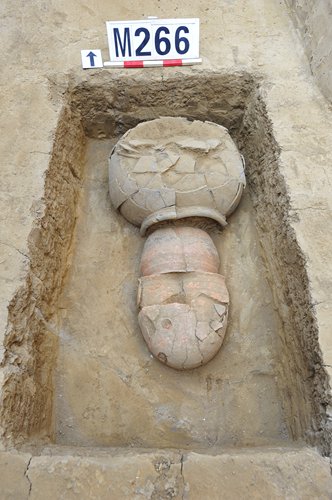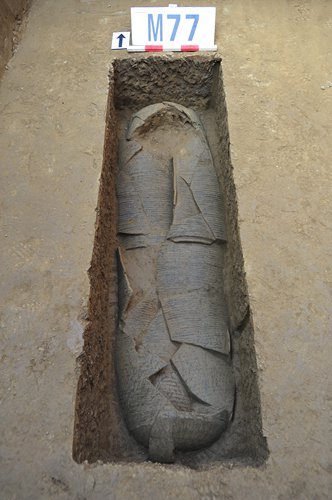
Burial urns for a child (left) and an adult discovered in Tongzhou in 2016 Photo: Courtesy of the Beijing Municipal Administration of Cultural Heritage

Burial urns for a child (left) and an adult discovered in Tongzhou in 2016 Photo: Courtesy of the Beijing Municipal Administration of Cultural Heritage
The discovery in 2016 of a number of archaeological sites in Beijing's Tongzhou district have helped to redefine the region's history.
According to the Beijing Municipal Administration of Cultural Heritage, several discoveries had been made in Tongzhou in 2016, including the unearthing of an astonishing number of burial urns for adults and more than a thousand ancient tombs dating back to as early as the Warring States (475BC-221BC) period.
According to a press release from the organization, the 7-month archaeological exploration and excavation project kicked off in February 2016, before the start of major construction projects meant to turn the district into a subsidiary administrative center for Beijing. The project covered numerous areas in the district to include Hugezhuang village, Houbeiying village and Gucheng village.
With the assistance of more than 2,000 professionals from nine archaeological institutions across the nation, 1.01 million square meters of land was explored, leading to the excavation of numerous relic sites, some of which reached 40,000 square meters in size. The discoveries include the remains of a Han Dynasty (206BC-AD220) city, 69 kilns that operated sometime between the Han to Tang dynasties (618-907), 1,092 tombs and burial sites dating from the Warring States period all the way to the Qing Dynasty (1644-1911) as well as a number of relics of historical significance.
A number of firsts
The fact that around 79 percent of the 1,092 tombs and burial sites discovered range from the Warring States through to the Han Dynasty proves for the first time that the Tongzhou region was, according to the statement, already "a populous and prosperous area as early as the Warring States," overthrowing previous historical views that the region was not significantly developed until the Grand Canal was built during the Sui (581-618) and Tang dynasties.
In addition, the discovery of a large number of bone suanchou, sticks used for mathematical calculations, in the district marks the first time such items have been unearthed in Beijing. What's more, the discovery of 62 burial urns is also believed to be the first time such a large number of burial urns had been discovered in Beijing. Twenty-three of these were also made for adults, an amount considered "unprecedented" in archeological circles.
Burial urns
"The discovery of urns for adults, some of which are two meters long, is definitely a first in Beijing history," the Beijing Youth Daily quoted Bai Yan, head of the Beijing Research Institute of Cultural Relics, in a report from December 19.
According to Bai, though burial urns have been found previously in places such as East China's Shandong Province, Liaoning Province in Northeast China and Hebei Province in North China, each find only consisted of a few urns, and almost all were made for children. The discovery of such a large number of burial urns for adults is certainly a rare find.
Bai told the Beijing Youth Daily that burial urns, a unique part of burial culture in Northeast Asia, usually features two earthenware urns, or sometimes basins, joined at their mouths to form a coffin. Such coffins were often made from pots meant for daily tasks and were mostly used to bury babies or children.
However, Bai pointed out that the urns for adults found this time were too long to have been daily use items. Additionally, buckles were also found on the urns to prevent the two connected sides from detaching, as such they were probably made specifically for burial purposes.
Though the remains inside the urns have not yet been identified, the discovery is a valuable asset for historians researching Beijing, Tianjin, and Hebei Province, or even in the areas around the Bohai Sea, Bai noted.
These urns may also provide insight into the history of other countries.
In an October article from the Hebei-based Yanzhao Metropolitan News, Bai Yunxiang, deputy head of the Institute of Archaeology under the Chinese Academy of Social Sciences, explained that burial urns had even spread to the Korean Peninsula and the Japanese archipelago during the late Warring State period and the early Han Dynasty.
Ancient city remains
Aside from the discovery of ancient tombs and burials, other significant discovery in the district was the remains of the ancient city of Lu from the Han Dynasty. The city is believed to have been an early political, military and transportation center for northern China during that time.
Some 500,000 square meters of the city remains have been excavated, according to the announcement, and the remains of an ancient city riverbed and a road dating from the Ming (1368-1644) to Qing dynasties have also been found.
Burial urns discovered in other provinces in 2016
October
Huanghua, North China's Hebei Province
According to a Xinhua News Agency report on October 8, experts discovered 107 burial urns for children and six for adults at the site of Fudi City, an ancient city dating back to the Warring States period, in Huanghua, North China's Hebei Province.
April
Bazhou, Hebei Province
On April 23, Xinhua reported that five burial urns were found at the bottom of a river running through the Tiangezhuang village in Bazhou, Hebei Province. The oldest among these urns dates back to the Warring States period.
January
Horinger county, Inner Mongolia Autonomous Region
A total of 58 burial urns for children dating from the Han Dynasty were found in the remains of Shengle City, an ancient city dating back to as early as the Spring and Autumn Period (770BC-476BC), according to a Xinhua report from January 11.


















































